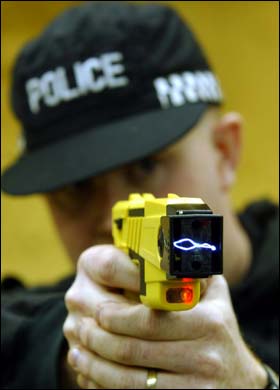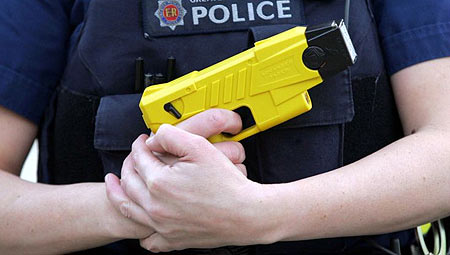[contextly_auto_sidebar]
 A new study carried out by Drexel University and Arizona State University in the USA, which was funded by the US Department of Justice’s National Institute of Justice, and which involved participants being subjected to 50,000 volt Taser shocks and then tested for cognitive impairment showed “short-term declines in cognitive functioning comparable to dementia”.
A new study carried out by Drexel University and Arizona State University in the USA, which was funded by the US Department of Justice’s National Institute of Justice, and which involved participants being subjected to 50,000 volt Taser shocks and then tested for cognitive impairment showed “short-term declines in cognitive functioning comparable to dementia”.
The researchers said the study raised “serious questions about the ability of police suspects to understand their rights at the point of arrest”. The study stated: “Taser exposure caused statistically significant reductions in verbal learning and memory. The effects lasted, on average, less than one hour.” The researchers point out that the study participants were high-functioning, healthy young people who were accustomed to test-taking, were sober and drug-free at the time that they were tasered and thus were functioning at a much higher level of cognition than would typical suspects in the field. Typical suspects might be high on drugs or alcohol or drunk, mentally ill or with some other crisis in process at the time of exposure to the Taser and thus would experience even greater impairment to cognitive function.
Other side effects were found to be difficulty in concentrating, increased levels of anxiety, emotional debilitation caused by the experience and a feeling of being overwhelmed. Professor White from the Arizona State University’s School of Criminology and Criminal Justice, and one of the report’ s authors, said:
“Tasers are a great alternative to deadly force. When used in lieu of firearms, Tasers can save lives. But using a Taser is not without risk although they are considered safe when used on healthy people, people have died from being Tasered. They should be treated as a dangerous weapon.”
The report raises issues concerning the rights of the accused/suspect protected by law, the use of force by police and the effects of the use of the Taser on the human body. More than 2 million citizens in the US have been tasered by police as more and more US police forces adopt the Taser as its preferred less lethal weapon (LLW). Statistics in the United Kingdom show that year-on-year the use of tasers has increased. Moreover, there is a vociferous campaign being mounted by certain senior police officers, Police and Crime Commissioners and by unions representing police officers for every police officer in the UK to be armed with a Taser.
Step into the unknown
Almost nothing was known about the effects of Tasers on human beings prior to the introduction of this weapon in the United Kingdom in 2003. No testing had been carried out on human beings before tasers were introduced and very limited testing has been carried out since. The Defence Scientific Advisory Council Sub-Committee on the Medical Implications of Less-Lethal Weapons (DOMILL) was the body charged by the Home Office with responsibility for assessing the medical implications of use of specific LLW systems and to give specific guidance to users. DOMILL has issued six statements relating to the medical implications of the Taser M26 and Taser X26 less-lethal systems, the last being in 2012 at the request of the Northern Ireland Policing Minister who tasked them to conduct an assessment of the medical implications of the use of tasers on children (aged 18 and under) and vulnerable adults.
DOMILL’s findings (PDF) were:
- A recent human study had shown that Taser discharge, applied through a barb that has penetrated the frontal chest in a region overlying the heart, is capable of inducing an inappropriately high heart rate by a mechanism known as cardiac capture. While a short period of rapid cardiac capture in young and healthy individuals may not have major clinical implications, serious complications could arise in those with impaired heart function caused by an underlying heart condition or through the action of certain licit or illicit drugs. Cardiac capture from chest-penetrating barbs may be more likely to arise in children and thin adults as the heart will generally be closer to the source of discharge.
- The physiological burden arising from the Taser-induced muscle contractions and associated pain, combined with the stressful circumstances in which Tasers are likely to be used, may adversely affect certain groups. These susceptible groups include the elderly, those with heart conditions, people who have taken certain drugs, and those affected by asthma or other pulmonary conditions.
- Risks to the pregnant woman and fetus from Taser discharge are incompletely understood. While there is no evidence that abdominal application of Taser discharge is able directly to induce uterine muscle contraction, Taser-induced muscle contraction commonly leads to falls. Fall injuries in general have been associated with an increased probability of delivery by caesarian section and low birth weight.
- Others who may be at heightened risk of injury from Taser-induced falls include people whose protective reflexes may be impaired, such as those intoxicated with alcohol, illicit drugs or certain prescription medications. People affected by osteoporosis, young people during the adolescent growth period, individuals with a history of a bleeding or clotting disorder and those on anticoagulant or antiplatelet therapy, may also be more prone to an adverse outcome following a fall.
- The intense muscle contractions induced by the Taser discharge may lead to musculoskeletal injury. Older people may be more prone to this type of injury.
- Children and thin adults may be at greater risk of internal injury from tissue-penetrating Taser barbs as body wall thickness generally will be less in these groups. Children and adults of short stature may also be at greater risk of injury to sensitive structures in the head and neck regions due to the closer proximity of these structures to the most commonly used point of aim (the frontal chest).
- There is equivocal evidence to indicate that Taser discharge may induce epileptic seizures following barb penetration of the scalp. There is also evidence to indicate that Taser discharge may trigger seizures in those affected by epilepsy, irrespective of barb location. Consistent with this, emotional stress and physical exertion, both of which are likely to feature in incidents involving administration of Taser discharge and many other forms of force, are among the seizure-precipitating factors reported by those affected by epilepsy.
- There is the potential for Taser discharge to be administered to individuals whose behaviour has been influenced by an underlying medical condition or with whom communication is in some way impaired due to non-medical reasons.
- Aggressiveness and non-cooperation may be manifested during and shortly after an epileptic seizure.
- Adverse changes to behaviour may be exhibited by those with uncontrolled diabetes.
- Language barriers and hearing or vision impairment may lead to difficulties in communication which may increase the likelihood of exposure to Taser discharge.
- Mental health conditions, learning difficulties and neurodevelopmental or neurobehavioural conditions (for example, cerebral palsy and autistic spectrum disorders) may negatively influence how affected individuals interact with the police and thereby elevate the risk of exposure to Taser discharge or other forms of force.
- The longer-term psychological implications of exposure to an extremely painful Taser discharge, especially among children, remain unexplored.
- Taser discharge is unlikely to differentially affect persons fitted with cardiac pacemakers or implantable cardioverter defibrillators. However, the effect of Taser discharge on the function of other types of implantable electronic devices, such as vagus nerve stimulators and cochlear implants, is unknown.
 Nearly 1000 deaths have been identified in the US as having been caused by or contributed to by Taser use. According to data collected by Amnesty International since 2001 and published in 2012, at least 500 people have died in the USA after being shocked with a Taser either during their arrest, in custody or while in jail. Autopsy findings in the US analysed by Amnesty International identified three factors as having been causal or contributory in the deaths: (a) drugs (mostly cocaine or methamphetamine), (b) alcohol, and (c) some form of delirium (variously described as agitated psychosis, excited delirium or psychotic delirium). There is no agreement in the medical world about the condition called “excited delirium” and it remains controversial and outside accepted and defined medical conditions. All or nearly all of reported cases of excited delirium involve people who are in police custody or are engaged in violent confrontation with the police. The deaths recorded and published by AI show that in 90% of the cases the deceased was unarmed.
Nearly 1000 deaths have been identified in the US as having been caused by or contributed to by Taser use. According to data collected by Amnesty International since 2001 and published in 2012, at least 500 people have died in the USA after being shocked with a Taser either during their arrest, in custody or while in jail. Autopsy findings in the US analysed by Amnesty International identified three factors as having been causal or contributory in the deaths: (a) drugs (mostly cocaine or methamphetamine), (b) alcohol, and (c) some form of delirium (variously described as agitated psychosis, excited delirium or psychotic delirium). There is no agreement in the medical world about the condition called “excited delirium” and it remains controversial and outside accepted and defined medical conditions. All or nearly all of reported cases of excited delirium involve people who are in police custody or are engaged in violent confrontation with the police. The deaths recorded and published by AI show that in 90% of the cases the deceased was unarmed.
In the UK we have seen cases where Tasers have been used on children under 18. Since Tasers were cleared for use on under-18s in 2007, their use on the young in England has grown from 29 in 2007 to 323 in 2011 – equivalent to almost one child every day. CRAE’s own research for their 2014 State of Children’s Rights in England report revealed that in 2013 Tasers had been used on 309 children with 29% of those aged between 13 and 15 years old. In 8% of cases the weapons were fired or the “drive stun” technique was used. The use of Tasers on children and young people in London by the Metropolitan Police rose almost six-fold over four years. CRAE state the evidence that is available indicates that children are at greater risk of injury to major organs, brain and eyes.
Lack of empirical evidence
Police forces have been criticised by mental health charities after Taser use figures revealed the use of Taser guns on people in mental distress. Many incidents were recorded of Tasers being used by police to stop people committing suicide or harming themselves in the past three years. The tragic case of Andrew Pimlott in April 2013 highlights the dangers of using tasers. Mr Pimlott, a man with a history of depression and alcohol problems, and clearly in the middle of a mental health crisis, died after suffering severe burns having doused himself in petrol and was Tasered during the incident. The Coroner’s jury found that the cause of the ignition was likely to have been the discharge of the Taser. Tasers should only be considered for use in the presence of flammable substances as a last resort, and after every other available option has been considered and discounted the IPCC stated in its report on the case.
This statement flies in the face of the DOMILL recommendations in 2008 that “the Taser may cause combustion of flammable solvents on the subject’s clothing. This may result in serious burns to the torso and head; the Guidance to Users must highlight and control the risk from flammable liquids such as petrol on the subject.”
Exposing an individual who is displaying mental illness; a health issue or even disability to an electrified incapacitation has yet to be documented as safe or, indeed, accepted as ethical. Electroconvulsive Therapy (ECT) cannot be administered in a hospital unless by a qualified doctor and under anesthetic but tasering someone is doing something similar and without anesthetic. In a 2007 article in the Police Quarterly journal, White and Ready noted that despite concerns about the use of Tasers, there is a lack of empirical evidence to inform the debate. This is especially apparent in relation to use of Tasers in mental health emergencies.
The Braidwood Inquiry was established in British Colombia, Canada following the death of Polish immigrant Robert Dziekanski at Vancouver airport in October 2007 minutes after he was shocked five times by Royal Canadian Mounted Police (RCMP) officers. At the time of his death he was one of 26 people to die in Canada since 2003 after Tasers were deployed against them. The Braidwood inquiry made 19 recommendations for restricting, monitoring and reporting on use of Tasers in B.C. which were accepted by the B.C. government. The Report also called for further safety studies, including a review of any new Conducted Energy Weapon (CEW). Among its findings, the Report noted that many of the individuals subjected to police Tasers were emotionally disturbed and cited the “unanimous” testimony from mental health experts that de-escalation and crisis intervention techniques, not electro-shock weapons, were the appropriate response.
The debate is not whether Tasers should be banned nor, I hope, is it whether all police officers should be armed with one. It is accepted that use of Taser in carefully controlled circumstances has demonstrated the potential to resolve conflict safely and offers police some safety in dealing with violent situations. However, Tasers were introduced without any thorough medical assessment of the impact on humans and too much reliance has been placed on the fact that in many cases (largely in the USA but also elsewhere including the UK) no harm appears to have been caused to many of those tasered. Further medical issues and concerns about Taser use have been slow to surface largely because most of the evidence is not collected and because those tasered have been those without a voice in law enforcement.
It has also been hampered by the aggressive defence of its product by Taser Inc, the manufacturers. The fact that many of those tasered around the world are not routinely medically examined means that data that might inform us on their use is lost. We all therefore need to have a debate on what should be recorded to ensure that what is recorded is informed as much by the need for accountability as for the need to have ongoing assessment of the medical and psychological effects of the use of this firearm. I argue that our international commitments and our adherence to the Rule of Law require that there is a suitable forum of medically qualified experts from various fields who will routinely examine and report on issues relating to the medical consequences of the use of tasers.
The use of Tasers on children is indefensible.
The UN Convention on the Rights of the Child (1989), which the UK ratified in 1991, states in Article 19: “Governments must do all they can to ensure that children are protected from all forms of violence, abuse, neglect and bad treatment by their parents or anyone else who looks after them.” Article 36 states: “Governments must protect children from all other forms of bad treatment.” The UK also ratified UN Convention against Torture and Other Cruel, Inhuman or Degrading Treatment or Punishment (1987) in 1988.
Long ago in 2007 the UN Committee against Torture decided that Tasers are a form of torture. Statistics suggest that if the use of deadly force or less lethal weapons against people unarmed and fleeing, armed only with vehicles or armed with less dangerous weapons and not attacking anyone were prohibited in the US it would make policing only slightly riskier while saving hundreds of lives over the next several years.
Prior to the introduction of tasers there was no suggestion that such a weapon was required to deal with problems created by children behaving violently. British police recorded 26,370 violent knife crimes during the 2014-15 fiscal year, including those used to threaten police. But British police have killed only one person armed with a knife since 2008. During that time, no British officers were killed by weapons other than guns. The use of tasers against elderly people, those with disabilities whether mental or physical and its use when the victim is in police custody or restrained by police (such as being handcuffed) is also indefensible unless all other methods of dealing with the problem, including assistance from appropriate non-police resources, have been tried or appropriately ruled out and there is a actual or a real risk of injury or worse to a third party.
Further, I remain concerned that the introduction of tasers has relegated the skills required to de-escalate violent or potentially violent situations to a much lower level. Such skills reduce the risk to the police officer, the subject and to the public. Indeed, these skills may be lost, as the experience in the US demonstrates, especially if tasers were to become standard issue to all police officers. The issue of a taser to every police officer would, I believe, condemn us to follow the US example where these weapons have become a method of coercing citizens to obey police officers and punishing them for not doing so.







